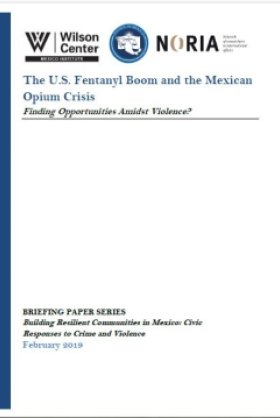The U.S. Fentanyl Boom and the Mexican Opium Crisis: Finding Opportunities Amidst Violence?
Posted date/time:

Mexico Institute

EXECUTIVE SUMMARY
- This report examines the effects of the upsurge in U.S. fentanyl use on opium producing areas in Mexico. By using available quantitative data on Mexican opium production as well as qualitative field research from opium producing communities in Nayarit and Guerrero, this paper offers valuable insights into Mexico’s illicit drug trade. In particular, this paper demonstrates the extent to which certain villages in the Golden Triangle, but also in Guerrero, Nayarit, and Oaxaca rely on opium production for survival.
- The authors estimate that the opium economy channeled around 19 billion pesos ($1 billion dollars) to some of the poorest communities in Mexico in 2017. This is a vast amount, nearly three times the total legal agricultural output of the entire state of Guerrero. Up to around 2017, opium growers in Mexico were earning around 20,000 pesos ($1,050 dollars) a kilo of raw opium, and families could bring in up to 200,000 pesos ($10,500 dollars) per year.
- With the upsurge in fentanyl use, the demand for Mexican heroin has fallen sharply, by an estimated 7 billion pesos ($364 million dollars). This has had an immediate knock-on for opium producers. Farmers are now being paid around 6000 to 8000 pesos ($315 – 415 dollars) per kilo of raw opium. These losses have caused farmers’ profits to disappear, village economies to dry up; and out-migration to increase.
- These findings have important implications for public security in Mexico, as well as major ramifications for international counter-drug efforts. Criminal groups in Mexico are nothing if not supple and adaptable to change. If current trends continue in the coming years, such groups may continue to dominate poppy-growing regions through other industries including illegal logging, illegal mining or the production of synthetic drugs.
- While legalization and crop substitution have been touted as possible alternatives, these should not be conceived of as silver bullets. However, if properly researched and managed, both policies could be introduced relatively cheaply and effectively. Initially at least, they would loosen the grip of organized crime groups on the regions and tie farmers to licit international markets. Combined with other broader security policies, they could integrate these marginalized areas into the country for good.
- Resolving this crisis requires further in-depth, policy-focused research in Mexico. It is urgent to design policies that are based on solid, updated knowledge about local dynamics of violence in the country. Any political response must be based on further research and diagnosis, conducted in the most critical opium producing regions of the country.
- Mexican government officials and international aid agencies should work to strengthen programs to promote long-term crop-substitution and economic development opportunities. Such policies are urgently needed to encourage local agricultural producers to focus on legitimate, locally sustainable crops and alternative industries.
- Recent proposals to legalize opium for the pharmaceutical industry should be considered seriously. Yet, legalization would only solve a one part of the issue, since Mexican demand for legal opioids is massively lower than the country’s current illegal production. Hence, the solution must be articulated both at the national and international level, in order to tackle supply and demand simultaneously.
Authors
Romain Le Cour Grandmaison
PhD Candidate, Sorbonne University
Nathaniel Morris
Leverhulme Early Career Research Fellow, History Department, University College, London
Benjamin T. Smith
Reader of Latin American History, University of Warwick

Mexico Institute
The Mexico Institute seeks to improve understanding, communication, and cooperation between Mexico and the United States by promoting original research, encouraging public discussion, and proposing policy options for enhancing the bilateral relationship. A binational Advisory Board, chaired by Luis Téllez and Earl Anthony Wayne, oversees the work of the Mexico Institute. Read more

Explore More
Browse Insights & Analysis
The OSCE is a Good Value for America
Posted date/time:

Mapping Undersea Infrastructure Attacks in the Baltic Sea
Posted date/time:

